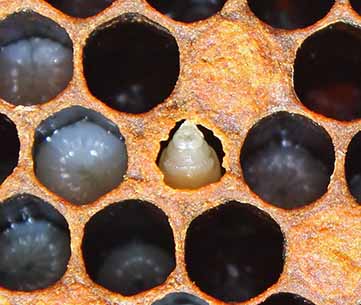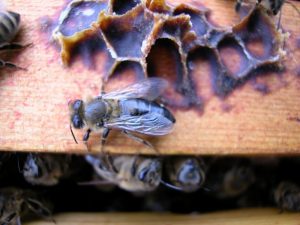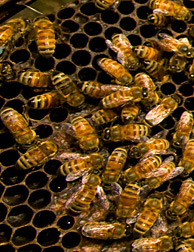Diagnosis of Honey Bee Diseases: Viral Diseases

The common bee Viral Diseases
1- Viral Diseases: Sacbrood

The only common brood sickness brought on by a virus is sacbrood. Laboratory verification is frequently dependent on physical symptoms and the lack of bacteria because sacbrood-diseased larvae are comparatively free of germs. Molecular methods or a specific antiserum are required for a positive diagnosis. Pearly-white larvae that are affected turn gray and then black. Just before pupation, when the larvae are upright, death occurs. As a result, damaged larvae are frequently discovered in capped cells. Typically, sick larvae develop their heads more slowly. The head area may tilt toward the center of the cell and is often darker than the remainder of the body. Affected larvae seem to be a sac filled with water when they are carefully removed from their cells.
2- Viral Diseases: chronic paralysis of bees

Adult bees suffering from chronic bee paralysis are typically located on the top comb bars. They are unable to fly and seem to shake wildly. When the situation is bad, a lot of bees are discovered crawling out the hive entrance. Typically, bees are glossy, hairless, and black. Toxic substances may occasionally be to blame for symptoms that resemble paralysis. Serological methods should ideally be used to diagnose this illness. The diagnosis is typically made by seeing symptoms in individual bees and, when possible, colony behavior because this is outside the scope of most laboratories. The signs of the condition can be reproduced in caged bees to identify chronic paralysis.
3- Viral Diseases: Virus Filamentous
F-virus and bee rickettsiosis are two additional names for the filamentous virus. Using dark-field or phase-contrast microscopy, this disease, which was formerly believed to have rickettsial origins, can be identified by looking at the hemolymph of infected adult bees. Infected honey bee hemolymph is milky white and contains a large number of spherical to rod-shaped virus particles that are near to the resolution limit for light microscopy.
4- Viral Diseases: Kashmir Bee Virus and Acute Paralysis

As two serologically related viruses, Kashmir bee virus (KBV) and acute paralysis bee virus (APBV), the antiserum made from one virus will also react with the other virus (Hung et al. 1996). These viruses frequently infect adult bees that appear to be in good health. Neither virus is known to produce any particular obnoxious symptoms. KBV is found to induce mortality in both adult and brood honey bees, in contrast to APBV, which affects only adults. Immunodiffusion testing can be used to identify APBV and KBV illnesses. Recently, molecular techniques for identifying both disorders were created. However, our lab does not frequently employ immunodiffusion or molecular techniques.
Relations between Viral Diseases
Paenibacillus larvae produce a powerful antibiotic that drives out competing bacteria that are often connected to honey bee larval environments. Due to this, colonies with both American foulbrood (AFB) and European foulbrood (EFB) are rarely encountered together, with the exception of situations in which AFB is just starting to spread over colonies with EFB. Linoleic acid, which is produced by Ascosphaera apis, prevents Melissococcus pluton and Paenibacillus larvae from growing. The prevalence of EFB has significantly decreased since the introduction of chalkbrood to the United States. The prevalence of AFB, however, seems to have remained stable. Although no single larva has been proven to be infected with more than one disease, it is not uncommon to see chalkbrood and sacbrood on the same comb or on a comb with larvae that have AFB. When choosing a sample for a medical diagnosis, it’s crucial to keep this in mind. The majority of adult bee illnesses are mixed infections. Adult bees may have N. apis infection in addition to viral or spiroplasma infection. Additionally, mature bees may have an infestation of one or more mite species.







